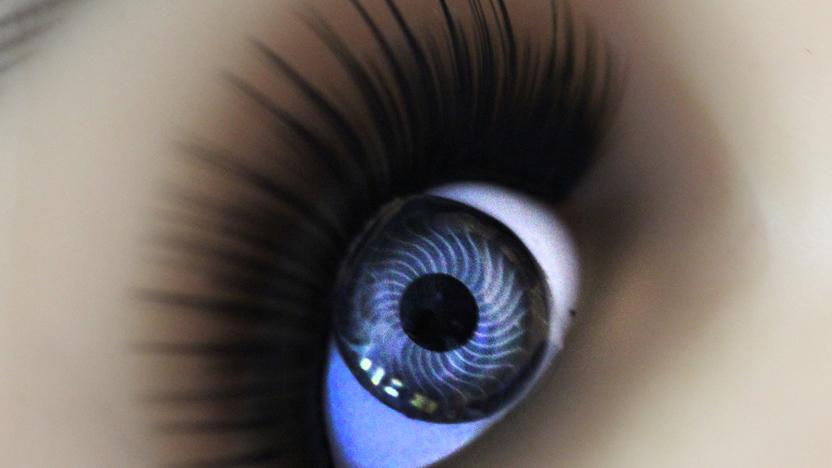TL18EYES
Latest

Scientists create ultra-thin membrane that turns eyes into lasers
It will still be a while before scientists are able to harness Superman-like laser vision, but the technology is now closer than ever before thanks to a new development from the University of St Andrews. The team there have created an ultra-thin membrane laser using organic semiconductors, which is for the first time compatible with the requirements for safe operation in the human eye. Even though the membrane is super thin and flexible, it's durable, and will retain its optical properties even after several months spent attached to another object, such as a bank note or, more excitingly, a contact lens.

Glucose-tracking smart contact lens is comfortable enough to wear
The concept of a smart contact lens has been around for a while. To date, though, they haven't been all that comfortable: they tend to have electronics built into hard substrates that make for a lens which can distort your vision, break down and otherwise cause discomfort. A team of Korean scientists might just come to the rescue. They've developed a smart lens that could help diabetics track blood glucose levels while remaining stretchable enough to be comfortable and transparent enough to preserve vision.

Retinal implant could add years to your eyesight
Scientists have been struggling to fight retinal degeneration in an elegant way. The most practical solution so far involves external devices that send wires to the back of your eyes. There might be a much more graceful approach before long, however. Researchers have developed an implant whose light-sensitive material could at least partially restore retinas and preserve your eyesight. Their invention combines a biocompatible substance (in this case, silk) with a conductive polymer and an organic semiconductor to send electricity to nerve cells whenever the implant is subjected to typical environmental light. Previous attempts at photovoltaic devices like this have required either exceptionally bright light or unusual light wavelengths to work, so this would be far more practical in the real world.

The power of tears: Why Google has its eye on smart contact lenses
When the cronut craze swept across New York in early spring of last year, the only major inconvenience associated with Dominique Ansel's novel culinary confection was the pain of waiting in line to get it. For a responsible person living with Type 1 (or Type 2) diabetes, like my good friend Cara, that wait time for a hip baked good would've been compounded by a few more irritating factors. First, there'd be a necessary finger prick test (administered in the open by an always on-hand glucometer) to measure blood sugar levels an hour before eating. Then, a guesstimate would need to be calculated of just how many carbs that precious SoHo sweet contained, followed by an adjustment of insulin delivery levels on a waist-worn pump. And, finally, a follow-up finger prick test would need to be done two hours after eating the cronut to once again establish a necessary insulin base line. That is true inconvenience. That is life with diabetes. And as you might imagine, not all diabetics are this disciplined. But Google wants to change that... with contact lenses.

Telescopic contact lenses magnify sight 2.8 times, turn wearer into cyborg
Interested in upgrading your eyeballs? Well, a team of DARPA-funded researchers led by Joseph Ford of UC San Diego recently published a proposal for a new type of telescopic contact lens in Optics Express. Designed for people with age-related macular degeneration, the lenses are only 1.17mm thick and can magnify images up to 2.8 times. Their layered construction admits light near the outer edge of the lens, bouncing it across a series of tiny aluminum mirrors before transmitting it to the back of the retina, kind of like the origami-optics lens. Telescopic sight can be toggled on and off by using a pair of 3D glasses to switch the polarization of the central part of the lens. It sounds promising, but the lenses -- pictured after the break -- currently have some obstacles, like gas-impermeable materials unsuitable for long-term wear and sub-par image quality. Want to read more? Pop on your glasses and check out the full paper at the source link below.

Scientists testing HUD contact lenses on rabbits, hope to bring augmented reality to your eyeballs
Scientists at Washington University are a step closer to bringing us all some sweet information displaying contact lenses. The team has been successfully testing prototype lenses on rabbits -- though there are some major caveats here. First, due to limits of circuitry, they can only display a single light-emitting diode at a time. Also, the scientists have yet to figure out a workable energy source -- at present, they need to be within centimeters of a wireless battery. The researchers have big plans, however, including the display of holographic images -- and, no doubt, information about which targets to destroy.




